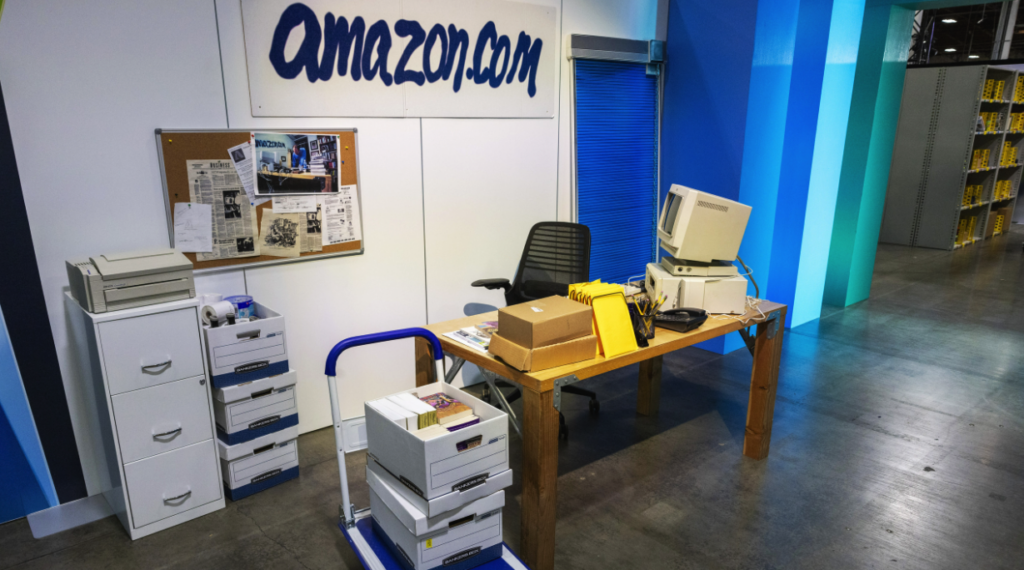- How It Began (You Guessed It, a Garage)
- 4 Key Components of Amazon's Brand Strategy
- The 4 P's of Amazon's Marketing Strategy
- Amazon's Digital Marketing Strategy
- Notable Amazon Advertisements
- Reach New Marketing Heights with MarcomCentral
Get news, updates, and insights delivered straight to your inbox.
Bookstores to Billions: A Case Study Analysis of Amazon’s Marketing Strategy

It’s hard to imagine a world without Amazon. The e-commerce giant has become synonymous with convenience, free shipping, and access to virtually every product a customer might need. Yet, like any other online retailer, Amazon started somewhere. This Amazon marketing strategy case study considers how the brand’s marketing efforts have contributed to the company’s success, starting with its humble beginnings in 1994 to its worldwide visibility and customer loyalty today.
How It Began (You Guessed It, a Garage)
Image Source: AboutAmazon.com
It might sound unbelievable to discover leading brands started as small businesses. In Amazon’s case, the cliché is true – the e-commerce company began in a garage.
July 5, 1994, marks the day Jeff Bezos officially founded Amazon, but it went by a different name – Cadabra. Bezos recently graduated from Princeton and used a spare garage space at his rental home near Seattle, Washington, to launch his small business.
Amazon began as an online bookseller, but Bezos has said that he’s never seen this as Amazon’s end. Instead, he saw bookselling as an ideal entry point into the broader world of e-commerce and technology. Bezos intended to expand his retail site to include products one might find at department stores, grocery stores, sporting goods stores, and more. As Bezos is credited with saying, “Strip malls are history.”
Amazon became the new name for Bezos’s company within just a few months, as Cadabra sounded too similar to the word cadaver. It made the online bookseller seem dead on arrival. On the contrary, Amazon was just beginning – and very much alive. While still in the garage space, the online retailer was already selling across the U.S. and over 40 countries worldwide.
At the start, Amazon underwent a challenge that many small businesses experience – suffering losses. However, mid-1996 served as a forecast of the brand’s success. Revenue rose by millions as losses fell significantly. From there, Amazon continued to innovate and grow.
Image Source: Fintechnews.com
In 2000, Amazon expanded its online store to third-party sellers. Independent retailers could use the platform to sell new, used, and other unique products, while Amazon handled logistical aspects and charged sellers transaction fees. Bezos, who always saw Amazon as a technology company, was also quick to introduce Amazon Web Services (AWS) in 2002 – a comprehensive suite of cloud computing services.
Then, in 2005, Amazon Prime was released. This membership program promised what few other e-commerce platforms could – fast, free delivery. This began as free two-day shipping for U.S.-based customers and has grown to include customers from across the globe. Amazon Prime also opened the door to entertainment offerings such as Prime Video and Amazon Music.
Amazon is marked by a clear vision and spirit of innovation. These qualities have allowed the e-commerce platform to become a major global player. But they’re not the only elements that make Amazon stand out. Amazon’s marketing campaigns have also supported the company’s growth, and it all starts with a strong brand strategy.
4 Key Components of Amazon’s Brand Strategy
Customer Experience
“A brand for a company is like a reputation for a person. You earn reputation by trying to do hard things well.” – Jeff Bezos, Founder When brands do customer experience well, many positives follow – customer loyalty, a boost in reputation, and potentially higher profits. As such, customer experience is a major focus for online retailers like Amazon.
Customer-Centric Approach
Part of what makes Amazon’s customer experience a cut above is a customer-centric mindset. What do Amazon customers (and by extension, all online retail customers) want? Ease is among the top preferences. One research study into why respondents choose Amazon found that 73% of customers like fast, free shipping, and 58% appreciate the convenient purchase process.
Of course, an Amazon Prime membership gives customers access to faster shipping and other perks, but even those not subscribed may have a more convenient online shopping experience. This is one aspect of the consumer’s mindset that Amazon understands well. Consumers don’t want to spend hours just to find what they need. The faster and more seamless a customer experience, the greater the chances the customer comes back.
Personalized Shopping Experience
Personalization is essential for a great customer experience. One way Amazon tailors the e-commerce experience is through intelligent product recommendations. Website technology considers an Amazon customer’s recently purchased items, those they’ve rated, and items they already own. It compares the customer’s activity with that of similar customers, scouring its product listings to find related items that might interest the customer.
A similar function is Amazon’s Choice, which goes a step further than suggesting products customers might need next. Think of Amazon’s Choice offerings as the cream of the crop of product recommendations. These are highly rated and come at a value. They’re also usually available for fast shipping and returned less often than similar offerings in the product category.
More Confidence to Buy with AI Reviews
Customers care what other people have to say about products. According to some research, more than 99.9% of customers read reviews when shopping online. The value of meaningful customer reviews isn’t lost on Amazon. Recently, the e-commerce platform has begun using artificial intelligence (AI) to summarize the list of reviews on product pages, so users get all the information they need right at the top to make an informed choice.
Less Stress Over Returns
Even with the most tailored e-commerce experience, returns are inevitable. When customers return products, it often signifies that the company failed to deliver customer satisfaction. Yet, Amazon sees an opportunity to provide a great experience – even with the return process.
Although some online retailers only allow customers to return unused products, Amazon lets customers test products and return them within a set period. This provides more confidence they made the right choice. There are also different ways to be refunded and multiple drop-off locations, making even the return process a breeze.
Diversification
It’s a long way from selling books for Amazon, with Bezos always knowing this wasn’t the extent of his e-commerce company. With such an emphasis on innovation, it’s no surprise that Amazon continually seeks to diversify it’s revenue streams.
Image Source: StreamTVInsider
Music, Movies, and Football: Amazon’s Entertainment Hub
With the foundation of Amazon as primarily a technology company, the brand recognized the impact of streaming services like Netflix and Spotify. It seized the opportunity to create streaming services Prime Video and Amazon Music, both accessible from the main site. Sports fans appreciate the Sports section of Prime Video, which enables subscribers to view live sports events such as Thursday Night Football.
Whole Foods Partnership
In August 2017, Amazon initiated one of its most successful partnerships when it acquired Whole Foods Market. Although Amazon Fresh was already offering customers fresh groceries, this acquisition swung the door wide open into the grocery space.
Customers regularly look for ways to save on groceries, and Amazon makes this possible by giving Prime members access to extra savings and special discounts. What’s more, Prime members can get unlimited delivery on groceries from Whole Foods Market and Amazon Fresh with their subscriptions.
Many Whole Foods Market locations also double as Amazon pickup and return hubs. Customers can grab their packages or conveniently complete a return any time they go grocery shopping. In this way, diversification has also helped Amazon improve the customer experience.
Amazon Web Services (AWS) w/ Generative AI
Amazon Web Services is more than just the fulfillment of Bezos’s vision to venture further into technology. It brings the company back to its roots, empowering small businesses like it once was with a range of cloud computing services.
When AWS was first launched in 2002, its early offerings included data insights on Internet and website traffic valuable to developers and marketers. 2006 marked the entry into more cloud computing services.
Now, AWS boasts more than 200 services accessed by users worldwide, including computing power, data storage, and generative AI, among others. It’s become a leader in the global cloud market and is the company’s most lucrative business segment. AWS yields about 50% of Amazon’s operating income.
Impact on Local Communities
In today’s socially and ecologically conscious world, it’s often not enough to deliver quality products at affordable prices with great customer service. Consumers want to support brands that recognize the challenges of individuals in the communities they serve. They want companies that give back.
An e-commerce giant like Amazon can have a hard time humanizing itself, compared with small businesses which might feel more down-to-earth. Yet Amazon is committed to resonating with its customers, and serving local communities is one important way to communicate that it cares.
Just as Amazon strives to diversify its products and services, its community efforts reflect a wide range of social concerns. Amazon works with community partners to develop programs to solve some of the biggest challenges communities face. These programs aren’t one-and-done. As Amazon states, “We focus on building long-term, innovative programs that have a lasting, positive impact.”
Check out some of the programs Amazon has initiated to serve local communities:
- Help for Hunger donates delivery services to food banks and related nonprofits so that these organizations can distribute meals to communities in need.
- The Housing Equity Fund enables Amazon to support the development of affordable housing for low-to-moderate-income people in the communities Amazon serves. Other investments empower families out of homelessness.
- Amazon leverages its capabilities and services to support governments, nonprofits, and concerned citizens with Disaster Relief and Response.
- Students from underserved communities gain greater access to computer science programs for a brighter future in technology-related paths through Amazon’s emphasis on STEM Education.
Empowering Their Employees
For any other company, the goal of becoming “Earth’s best employer” might seem lofty. With Amazon, it simply reflects an attitude that’s been there since the beginning. Amazon Career Choice is the company’s program for helping employees gain the skills they need to achieve their career aspirations. It strives to remove barriers that employees may have in applying for higher education programs through several initiatives. Amazon partners with several schools and businesses, guiding employees with each step from education to career.
Beyond Amazon Career Choice, the company offers numerous technical and non-technical career opportunities, which range from internships to full-time positions. Amazon recognizes the diversity of its customer base and is intentional about maintaining a workforce that reflects this diversity. In addition to helping create job opportunities for individuals of different backgrounds and perspectives, a commitment to diversity helps Amazon deliver its custom-centric experience.
The 4 P’s of Amazon’s Marketing Strategy
Image Source: Amazon-Asin.com
With such a strong basis in its brand strategy, it’s no wonder Amazon has experienced tremendous marketing success. The company has launched various marketing campaigns throughout the years, and part of its ability to maintain consistency is covering every base of the marketing mix.
Product
It’s a far cry from the bookselling of Amazon’s early years. Amazon sells a range of products to meet virtually a customer’s every need. Clothes, home appliances and décor, electronics, sports and outdoor items, and yes, books, are all available through the e-commerce platform. Many items are sold by independent retailers, but customers can also shop for products through the brand’s signature line – Amazon Basics.
Price
For many customers, nothing comes before an unbeatable price. Even as brand reputation and quality might come before price for other consumers, it’s still a critical factor in deciding whether to buy.
Online retailers have several options when establishing a pricing strategy. Amazon’s main approach is often competitive pricing, which considers how much competitors charge to set prices. The goal is to keep costs low while ensuring customers have several choices.
For a company like Amazon, which experiences fluctuations in product listings regularly, competitive pricing is resourceful because it’s dynamic. It often makes it difficult for other e-commerce platforms and retailers to compete. However, Amazon might also leverage other pricing methods, such as promotional and behavioral pricing.
Everyone loves a bargain, something that promotional pricing counts on. There are circumstances where Amazon’s primary goal is to drive sales, so the company might reduce prices on certain products. It might be that a customer needs the promoted product, but this strategy also attracts the segment of Amazon’s target audience that can’t resist a deal. Promotional pricing is typically a temporary solution, either to generate interest in new products or to convert potential customers.
Behavioral pricing takes a more in-depth look at consumer habits to influence prices. It involves data analytics of demographics, purchase history, and other key information to understand why customers make purchasing decisions. Part of the broader approach of behavioral economics, this pricing method seeks to boost profits by examining consumer buying patterns and motivations.
Special events offer unique opportunities to play with pricing. Like other retailers, Amazon offers Black Friday and Cyber Monday deals. Last year, Amazon extended this season of sales, which started November 17th and ended November 27th. According to a press report from Amazon, customers saved about 70% more during the 2023 promotion than the previous year, indicating the value such sales initiatives provide – especially as the holiday season approaches.
Perhaps Amazon’s most famous day of deals – Prime Day – also exceeded records in its most recent iteration in 2024. Prime members receive exclusive deals on Amazon products across popular categories. In addition to encouraging shoppers to subscribe to Prime if they haven’t already, this event serves as a reminder of the convenience, low prices, and selection that is the Amazon brand.
Place
Considering Amazon is most known as an e-commerce platform, it can be difficult to grasp the power of its presence. As we’ve previously explored, Amazon’s digital presence spans across services. E-commerce is just one segment of a larger assortment of offerings that includes cloud computing and streaming services, among others.
With the e-commerce company serving customers across so many communities worldwide, it’s become a common question – how can Amazon deliver such fast shipping? This is where place fits into the marketing mix.
Amazon recognizes that it’s the people who make its one-of-a-kind customer experience possible. These teams need designated workspaces to make it happen, which Amazon provides through its vast fulfillment network. Although technology plays a significant role, it’s also the different buildings that enable a seamless flow of products from warehouses to customers’ doorsteps.
Fulfillment centers are separated between sortable and non-sortable for picking, packing, and shipping different types of products. Sortation centers are where orders are sorted by destination and placed on trucks to ensure fast delivery. Delivery stations are the final step in preparing orders for last-mile delivery. On the other end are receive centers, where inventory is organized based on its ability to sell.
Outside these fulfillment centers, the e-commerce company has begun opening physical Amazon stores that operate like traditional retail locations. Options like Amazon Go and Amazon Fresh bring the convenience of grocery shopping and pickups and deliveries that customers have come to expect from online retail services.
Promotion
Now we reach the aspect that most ties into Amazon’s marketing strategy – promotion. Think of promotion as an extension of brand awareness. It’s how Amazon communicates its offerings to the target audience. Amazon’s advertising strategy is as diverse as its profile of products and services and incorporates a range of traditional and digital techniques.
Amazon’s Digital Marketing Strategy
For a business as broad as Amazon, the target audience is everyone. This creates more opportunities for the e-commerce company but can make it challenging to know how and where to launch marketing campaigns. Amazon needs a digital resource where it can cast the widest net, and social media offers one of the best chances for a great catch. See how Amazon leverages different popular social media platforms for advertising:
Amazon uses Facebook for direct and indirect marketing. More direct approaches involve promoting sales to get customers to the e-commerce site. Facebook also offers a digital location for news stories, helping the customer base stay updated on developments happening at Amazon. This keeps Amazon top of mind, so customers think about the company even when they don’t intend to buy.
Twitter has evolved significantly in recent years, but it remains a key resource for social media marketing. Twitter is an ideal platform for sharing various types of content marketing, from standard copy to images and videos. Amazon can participate in trends and rely on algorithms for different campaigns to secure new customers.
Instagram’s photo and video-focused content enables effective visual advertising. Here, Amazon may partner with influencers to share product ads in a way that feels more human than traditional marketing.
YouTube
YouTube serves as a social platform for entertaining and educating viewers. Whatever type of content users search for, you can be sure they want to be engaged. As such, YouTube encourages Amazon to get creative with video ads that seize the target audience’s attention. This might be broad appeal or focused on resonating with a segment of the broader audience. No matter the case, the goal is often to leave viewers with an emotional impression of Amazon.
Pinterest is a hobbyist’s social media platform. Creative people turn to Pinterest for inspiration with their projects, whether home décor, cooking/baking, or fashion. The topics people search for on Pinterest correlate with Amazon’s product categories, allowing marketers to target audience segments based on their interests.
Affiliate Marketing Program
Amazon is no stranger to partnerships, so it makes sense the e-commerce giant would offer one of the largest affiliate marketing programs in the world. The Amazon Associates Program connects content creators, publishers, and similar individuals and groups with opportunities to monetize content. These blogs and articles lead to product recommendations that align with the topics these creators already discuss, with fashion, home décor, and organization being three of the most popular topics. Customized linking tools enable creators to share about products and programs and earn money.
Social media isn’t the only piece of Amazon’s digital marketing strategy, with pay-per-click (PPC) advertising also playing a role. Amazon’s PPC advertising consists of three main efforts, including sponsored product ads, product display ads, and headline search ads. Each has a distinct purpose. Display ads encourage customers to consider similar items to those in their cart. Headline and sponsored ads help increase the visibility of an Amazon seller’s offerings.
Notable Amazon Advertisements
We’ve talked a lot about Amazon’s marketing strategy, from how its brand strategy serves as a bedrock of its marketing mix to its digital presence across multiple marketing channels. But what does it look like when all these elements come together in a marketing campaign? These noteworthy examples show how Amazon’s marketing plan, mixed with creativity, can lead to powerful results:
“Saving Sawyer” Amazon ad becomes one of the most popular to air during Super Bowl LVII. It showcases a family using the e-commerce platform to purchase a kennel for a furry companion for their lonely dog left alone at home during the day.
“Joy Ride” ad airing in anticipation of the 2023 holiday season, which uses emotion and sincerity to resonate with the target audience.
Partnership with rap star Megan Thee Stallion to promote Prime Day 2024
The festive “Can You Feel It?” ad campaign, which aired during the 2018 holiday season, features packages with the signature smile logo singing as Amazon helps shoppers celebrate the holidays.
“Magical Day Out” AWS ad showcases how these cloud computing services help users navigate everyday tasks.
An action-packed “BusinessTransformed” AWS ad highlights how services like generative AI, machine learning, and access to real-time data allow users to bring fantastical ideas to life.
Reach New Marketing Heights with MarcomCentral
What will it take for your brand to stand out in the retail industry? It might seem impossible to reach the level of Amazon but remember how this e-commerce legend started small. Start by understanding your marketing goals. Do you want to increase efforts with a specific type of campaign, such as email marketing or search engine optimization (SEO)? Maybe you’re launching a new line of products and want to generate awareness and interest.
Whatever your objectives for revisiting your marketing strategy, it helps to have a centralized portal for managing all collateral – print and digital. MarcomCentral offers an on-demand marketing platform that simplifies the management of brand assets. Additional solutions make it easy to maintain compliance with industry standards, automate workflows, and distribute collateral – even with dispersed teams.
Contact us today to schedule a demo and learn how MarcomCentral can help your business. You can also explore other marketing case studies for insights and inspiration into your industry’s top brands.






